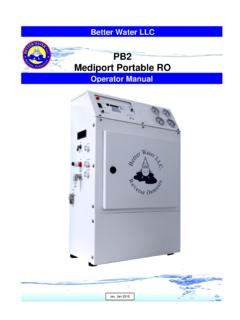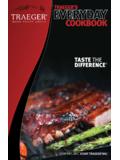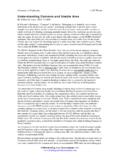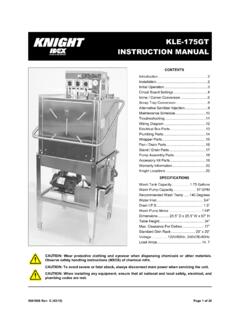Transcription of Impact Firecrackers - Private Data
1 ImpactFirecrackersbyJohn DonnerrevisedNovember 1996copyright 1996 Table of ContentsSection PageI. Introduction 1II. Chemicals 3 III. Globe Torpedoes 6IV. Cap Torpedoes 10V. Cane Torpedoes 12VI. More Cap Torpedoes 15 VII. Charles Nelson's Clay Torpedoes 17 VII. Cracker Balls 20 VIII. Auto Tire Blow-out Simulator 22IX. Exploding Blow Gun Darts 24X. Bibliography 27XI. End Notes 29 Impact Firecrackers1 IntroductionImpact Firecrackers results from several years of experimentation with differentmethods of making old-fashioned toy torpedo fireworks.
2 Impact Firecrackers is not intendedas a comprehensive text for the novice pyrotechnist. Impact Firecrackers describes construc-tion of some of the old fireworks torpedoes, most of which have not been accurately detailed inprevious literature. Scant attention is paid here to basic lab procedure or basic pyrotechnicsafety procedures -- a knowledge of these is presumed for anyone who might seriouslycontemplate reproducing the experimental procedures in this report. Never the less, I referanyone who needs basic safety training to Weingart's Pyrotechnics and to Lancaster'sFireworks: Principles and Practice as good sources for safety information.
3 The author of" Impact Firecrackers " merely describes procedures, and does not advocate duplicating thework recorded in this Firecrackers is divided into three sections: a brief introduction, a section onchemicals used in this process, eight sections that describe small-scale, experimental manufac-ture of torpedoes, annotated bibliography, and end years ago toy torpedoes, Impact actuated exploding fireworks, were very popularfireworks items in the -- particularly popular with young ladies. Fireworks manufacturersproduced many sizes and kinds, using a variety of explosive compositions before they werefinally banned in the late 1950's.
4 The tiny "Snap'n'Pops" of today are mere shadows of thetoy torpedoes once available. Some of the more famous varieties of that bygone era were thesilver torpedo, Globe Torpedo, the tube type torpedo, the "safety torpedo", the cracker ball,the ball-type cap, and the so-called "Japanese cap torpedo". Patent documents reveal manykinds of torpedoes of which the inventors thought well enough to expend the considerable timeand money inherent in the patent process (1).From the standpoints of relative ease and safety of construction, safety of storage,transportation, and use, the Globe Torpedo is arguably the best option for the novice torpedomaker.
5 The other varieties described call for use of more sensitive compounds such as chlorate/ phosphorous, or chlorate / sulfide / magnalium compositions. All of these compositions aredangerous. You be the judge: how skillful and more importantly, how foolhardy are you? Technical information about torpedoes is scarce, but for further information one canexamine The Chemistry of Powder and Explosives by Tenney L. Davis, Pyrotechnics byGeorge Weingart, Fireworks: The Art, Science and Technique, by Takeo Shimizu, and variouspatent listings since the late 19th century.
6 Weingart's text, Pyrotechnics, describes themanufacture of silver fulminate torpedoes (2) and should be consulted as the best extantpublication describing the silver fulminate torpedo. An interesting inside look at the manufac-ture of torpedoes from a nostalgic viewpoint is provided in the essay, "Cherry Bombs andSilver Torpedoes" by John Drewes. Other interesting items relating to torpedoes can be foundin some children's literature of the late nineteenth and early twentieth centuries; some of this2material has been reprinted in Pyro-Fax, a periodical published by the Fourth of July America-na Museum.
7 Overall, though, reliable information about the early history of torpedoes isscarce. Torpedoes prepared with fulminating salts may conceivably have been around since themiddle ages or even earlier -- prepared in the laboratories of the alchemists in their ceaselesssearch for the transmutation of metals. This, however, is conjecture. I am not aware of anyrecord that would support that hypothesis. The chlorate based torpedoes can be dated withrelative certainty to the era after 1789, the year when Berthollet is credited with people have been seriously injured while using, and especially while attemptingto manufacture fireworks.
8 There is always risk in the manufacture and use of dangerousarticles such as these. Those who learn as much as they can about what they are doing stand amuch better chance of survival intact than those who do not. Do yourself a favor, and alwayswork to minimize hazards and risks. A little knowledge is a dangerous Firecrackers3 ChemicalsThe following briefly describes chemicals used in these processes, and some of their propertiesand hazards. For further information, consult other sources, such as the publications listed inthe powder (Al) Aluminum powder used in fireworks is available in many grades,usually described by particle size (mesh number) and particle shape.
9 The finer the size, andthe flatter the particle shape, the more reactive the aluminum will be. For the manufacture oftorpedoes the preferred grade is called German Black, which is finer than 400 mesh size, andof the "flake" shape. Antimony Sulfide (Sb2S3) Antimony sulfide is a very reactive fuel often used in fireworksmaking. Antimony salts are toxic, and often have some arsenic content, which is also toxic. For use in torpedoes, the chemical should be a very fine powder, at least 350 mesh, preferablyfiner.
10 The relatively soft crystals can be ground with steel balls in a ball mill to the Dextrin is a chemically modified starch that is used as a binder in many pyrotechniccompositions. It is very sticky when wet, dries very hard, and is Quartz gravel of the grade used in aquariums, about 10 or 15 mesh and not polished isideal for use in torpedoes. The white marble variety does not work nearly as well because ofits low specific gravity and hardness. Magnalium (Mg/Al alloy) This is an alloy of magnesium and aluminum that is frequentlyused in pyrotechnics.






